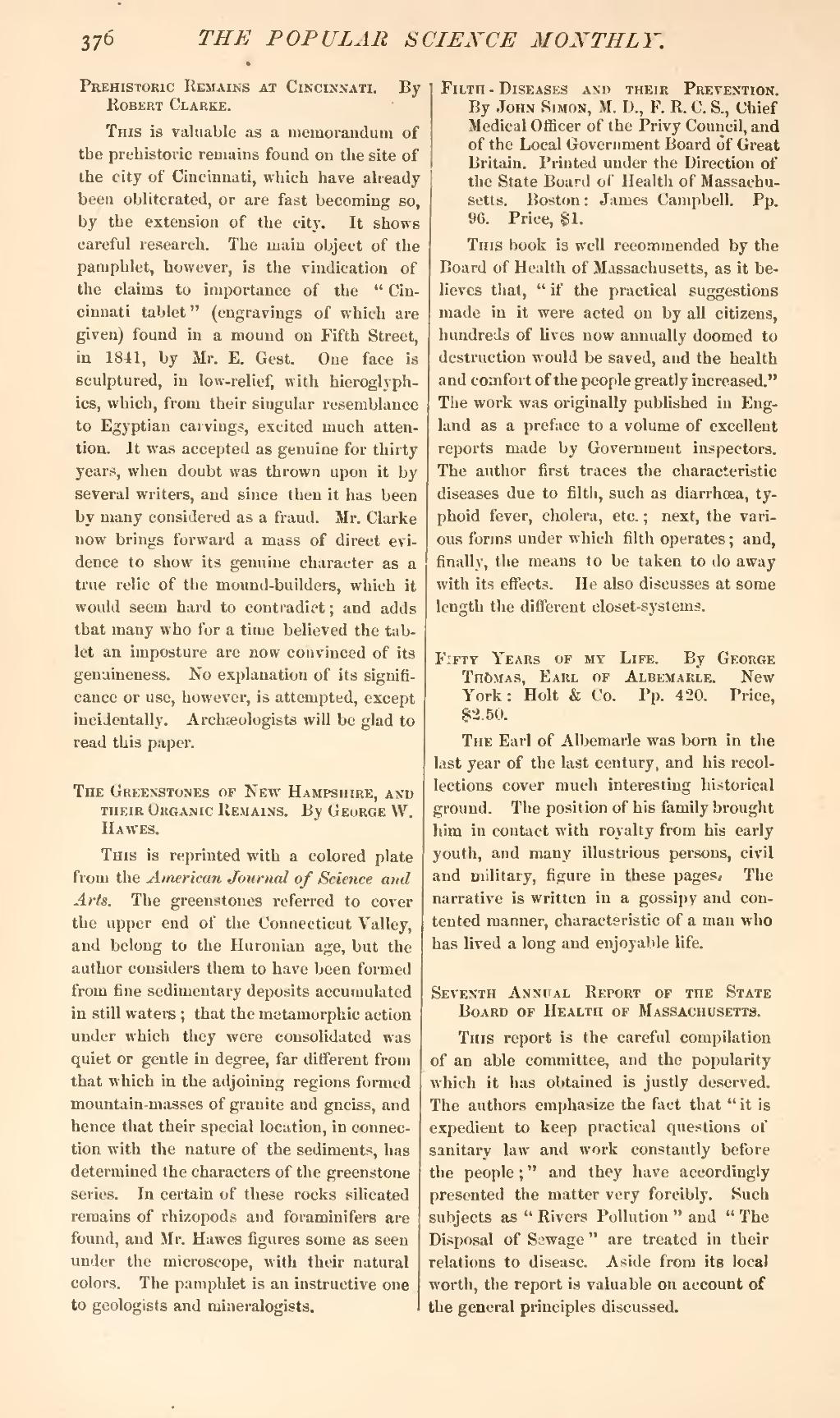Prehistoric Remains at Cincinnati. By Robert Clarke.
This is valuable as a memorandum of the prehistoric remains found on the site of the city of Cincinnati, which have already been obliterated, or are fast becoming so, by the extension of the city. It shows careful research. The main object of the pamphlet, however, is the vindication of the claims to importance of the "Cincinnati tablet" (engravings of which are given) found in a mound on Fifth Street, in 1841, by Mr. E. Gest. One face is sculptured, in low-relief, with hieroglyphics, which, from their singular resemblance to Egyptian carvings, excited much attention. It was accepted as genuine for thirty years, when doubt was thrown upon it by several writers, and since then it has been by many considered as a fraud. Mr. Clarke now brings forward a mass of direct evidence to show its genuine character as a true relic of the mound-builders, which it would seem hard to contradict; and adds that many who for a time believed the tablet an imposture are now convinced of its genuineness. No explanation of its significance or use, however, is attempted, except incidentally. Archæologists will be glad to read this paper.
The Greenstones of New Hampshire, and their Organic Remains. By George W. Hawes.
This is reprinted with a colored plate from the American Journal of Science and Arts. The greenstones referred to cover the upper end of the Connecticut Valley, and belong to the Huronian age, but the author considers them to have been formed from fine sedimentary deposits accumulated in still waters; that the metamorphic action under which they were consolidated was quiet or gentle in degree, far different from that which in the adjoining regions formed mountain-masses of granite and gneiss, and hence that their special location, in connection with the nature of the sediments, has determined the characters of the greenstone series. In certain of these rocks silicated remains of rhizopods and foraminifers are found, and Mr. Hawes figures some as seen under the microscope, with their natural colors. The pamphlet is an instructive one to geologists and mineralogists.
Filth-Diseases and their Prevention. By John Simon, M. D., F. R. C. S., Chief Medical Officer of the Privy Council, and of the Local Government Board of Great Britain. Printed under the Direction of the State Board of Health of Massachusetts. Boston: James Campbell. Pp. 96. Price, $1.
This book is well recommended by the Board of Health of Massachusetts, as it believes that, "if the practical suggestions made in it were acted on by all citizens, hundreds of lives now annually doomed to destruction would be saved, and the health and comfort of the people greatly increased." The work was originally published in England as a preface to a volume of excellent reports made by Government inspectors. The author first traces the characteristic diseases due to filth, such as diarrhœa, typhoid fever, cholera, etc.; next, the various forms under which filth operates; and, finally, the means to be taken to do away with its effects. He also discusses at some length the different closet-systems.
Fifty Years of my Life. By George Thomas, Earl of Albemarle. New York: Holt & Co. Pp. 420. Price, $2.50.
The Earl of Albemarle was born in the last year of the last century, and his recollections cover much interesting historical ground. The position of his family brought him in contact with royalty from his early youth, and many illustrious persons, civil and military, figure in these pages. The narrative is written in a gossipy and contented manner, characteristic of a man who has lived a long and enjoyable life.
Seventh Annual Report of the State Board of Health of Massachusetts.
This report is the careful compilation of an able committee, and the popularity which it has obtained is justly deserved. The authors emphasize the fact that "it is expedient to keep practical questions of sanitary law and work constantly before the people;" and they have accordingly presented the matter very forcibly. Such subjects as "Rivers Pollution" and "The Disposal of Sewage" are treated in their relations to disease. Aside from its local worth, the report is valuable on account of the general principles discussed.
